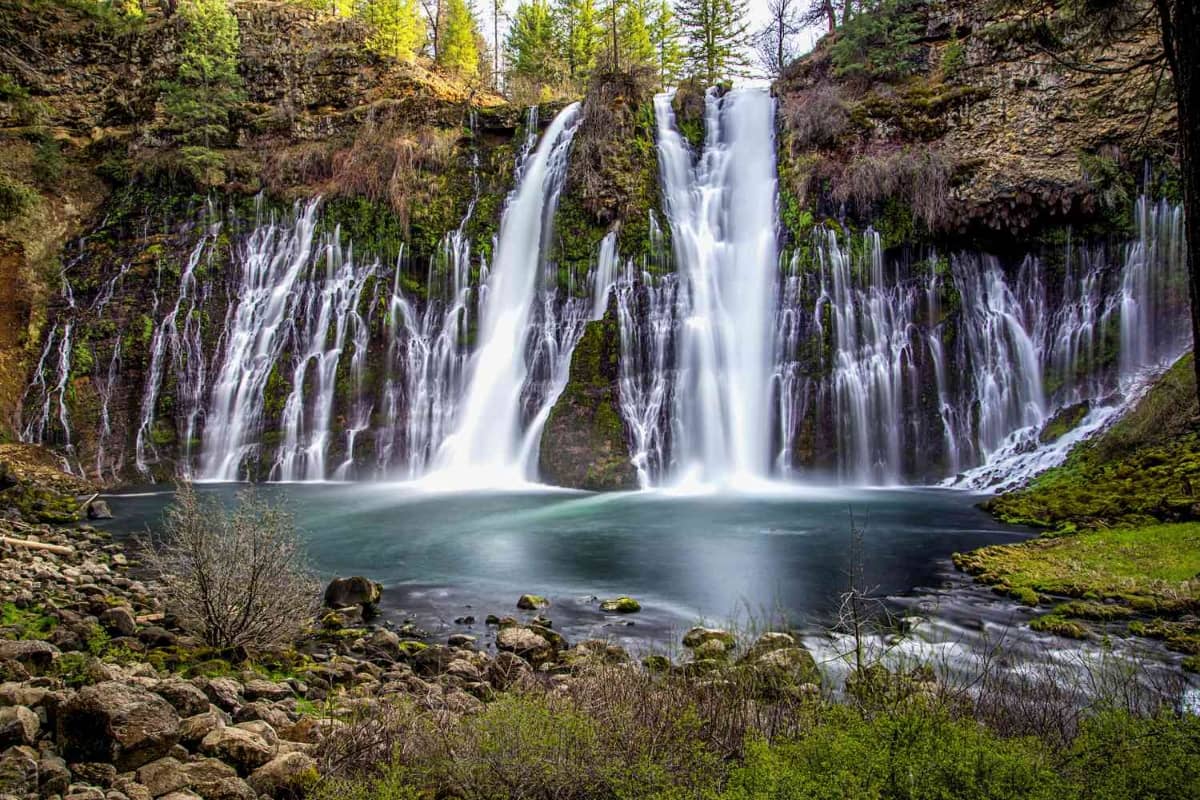Burney Falls, located in Northern California’s McArthur-Burney Falls Memorial State Park, is one of the most captivating waterfalls in the region. Though it is renowned for its breathtaking beauty, visitors need to be aware of potential dangers that could turn their trip into an unfortunate experience. This article will explore six hidden dangers at Burney Falls, helping you prepare for a safe and enjoyable visit.
Slippery Trails and Terrain
The trails surrounding Burney Falls, particularly the Loop Trail that provides access to the base of the falls, can be treacherous. Mist from the 129-foot-high waterfall keeps the paths damp year-round, making them consistently slippery. In winter, these paths become even more dangerous as they freeze over, leading to icy conditions. Despite the allure of getting closer to the falls, scrambling over rocks to reach better vantage points is risky due to the slick surfaces. Visitors should wear sturdy, non-slip shoes and remain cautious when walking near the falls.
Freezing Water Temperatures
Though the pool at the base of Burney Falls might appear inviting on a warm summer day, the water is far too cold for swimming. The temperature hovers around 42°F (5.5°C), which can lead to cold shock or hypothermia if you’re submerged for too long. Additionally, swimming near the falls is dangerous because the powerful currents can quickly sweep swimmers away. While swimming is technically allowed in the nearby Lake Britton, it is highly discouraged at the base of the falls due to these safety concerns.
Rock Scrambling Hazards
Many visitors are tempted to climb the rocks near the base of the falls to get a closer look or take photos, but this poses a significant hazard. The rocks are often slick from the constant mist, and their uneven surfaces make for unstable footing. A fall from one of these rocks could result in serious injury. While the desire for the perfect photo or a better view might be strong, it’s best to admire the falls from the designated observation areas and well-maintained trails to avoid the risk of injury.
Parking Problems and Traffic Hazards
One of the less obvious dangers at Burney Falls is related to parking and traffic. The park’s popularity, especially during the peak summer months, means that parking lots often fill up by mid-morning. Once the lots are full, many visitors resort to parking along Highway 89, which is illegal and dangerous. The highway is frequented by fast-moving vehicles, including large trucks, which can pose a significant risk to those walking along the road to reach the park entrance. Illegally parked cars are also subject to towing, adding frustration to an already stressful situation. To avoid these issues, it’s recommended to arrive early or visit during off-peak hours, such as early morning or late afternoon.
Erosion and Storm Damage
Burney Falls and its surrounding trails have suffered from storm damage in recent years, leading to significant erosion in certain areas. As a result, some trails may be closed for maintenance to prevent accidents. The PSEA Trail and portions of the Falls Loop Trail have been closed due to this erosion. Even on open trails, erosion can make the terrain unstable, increasing the risk of falls or landslides. Visitors should always respect trail closure signs and stay on designated paths to minimize their exposure to these dangers.
Wildlife Encounters
Burney Falls is located in a remote, forested area, and it’s not uncommon to encounter wildlife while hiking or camping in the park. While animals such as deer, squirrels, and birds are a pleasant sight, more dangerous wildlife like bears can also be present. Bears are particularly attracted to food left in campsites or improperly stored garbage. It’s essential for visitors to store food securely and dispose of waste in bear-proof containers. Additionally, encounters with aggressive wildlife can occur, so it’s vital to be vigilant and know how to respond to a bear encounter. While bear attacks are rare, the possibility remains, and preparedness is key to staying safe.
Additional Safety Tips for Visiting Burney Falls
In addition to these six hidden dangers, there are several general safety tips to keep in mind when visiting Burney Falls. Firstly, the waterfall is surrounded by dense forests, and parts of the trail can be secluded. It’s important to hike with a partner or group and to let someone know your plans before setting out. Visitors should also carry plenty of water, as dehydration can be a concern, particularly during the hot summer months.
Bringing a map of the park or downloading trail maps before your visit is recommended, as cell service in the area can be unreliable. The park is relatively small, but it’s easy to lose your way without a clear guide, especially if you’re exploring lesser-used trails.
Lastly, while Burney Falls is accessible year-round, winter visits require extra preparation. The roads leading to the falls can be closed due to heavy snowfall, so it’s essential to check road conditions before setting out. If you’re hiking in winter, crampons and trekking poles may be necessary for navigating icy sections of the trail.
Conclusion
Burney Falls is undeniably one of Northern California’s most stunning natural attractions, but visitors must be aware of the hidden dangers that can arise during their visit. From slippery trails and cold water to rock scrambling hazards and the risk of wildlife encounters, there are many factors to consider when planning a trip to this beautiful location. By taking the proper precautions—such as wearing sturdy shoes, avoiding swimming near the falls, and respecting trail closures—visitors can safely enjoy the breathtaking beauty of Burney Falls without putting themselves at risk. Always remember to prioritize safety and make informed decisions to ensure your visit to Burney Falls is a memorable and safe experience.






